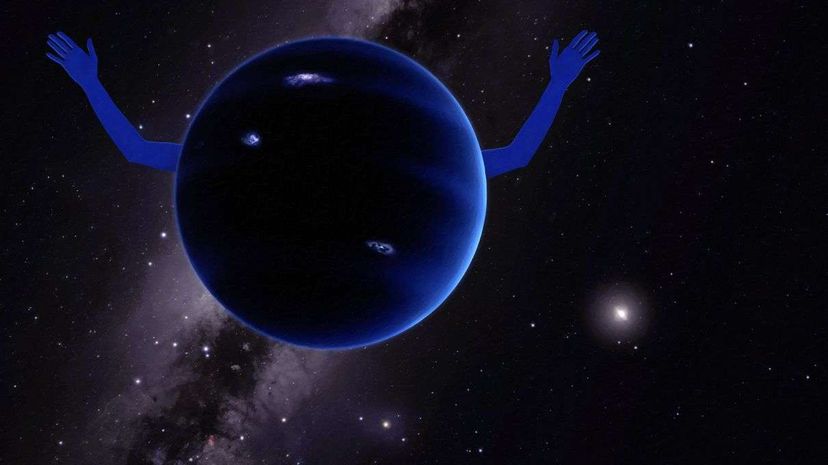
Two California Institute of Technology researchers recently made headlines when they published an article in the Astronomical Journal, announcing that they'd found evidence of a giant planet on the edge of our solar system, moving in a strange, elongated orbit as far as 93 billion miles (150 billion kilometers) from the sun.
The newly discovered world, which they nicknamed Planet Nine, appears to be 15 times farther from the sun than Pluto and about 5,000 times more massive than the dwarf planet, which was stripped of its full-size planet status and demoted by the International Astronomical Union back in 2006.
Advertisement
“This would be a real ninth planet,” Caltech professor of planetary astronomy Mike Brown, who found the evidence for the planet, along with colleague Konstantin Batygin, explained in a press release. Unlike Pluto, Planet Nine could be so massive that its gravity dominates a region of the solar system that's bigger than any of the other known planets — something that Brown said makes it “the most planet-y of the planets in the whole solar system.”
But those who aren't space scientists may be a little puzzled. If Planet Nine is so gosh-darned humongous, then how come it took so long for somebody to realize it was out there? And why hasn't anybody actually seen it? (Brown and Batygin figured out that it probably exists by using mathematical modeling and computer simulations, not direct observation.)
But when we think things like that, we're only revealing how little we know about the immense scale of our solar system, and the challenge of perusing that vast expanse. If anything, what's really remarkable is that someone could discover Planet Nine at all. Doing that required not just ingenuity but a series of prior discoveries and false starts that eventually provided clues about the probable existence of the giant world.
One thing that makes Brown and Batygin's discovery even more remarkable is that Planet Nine could be the first true planet (sorry, Pluto) that's been discovered since 1846. That's when German astronomer Johann Gottfried Galle officially observed the planet Neptune for the first time. He knew where to look because two other scientists, John Couch Adams of Britain and Frenchman Urbain Jean Joseph Le Verrier, had noticed that the planet Uranus was being pulled slightly out of its normal orbit, and calculated that the effect was being caused by yet another unknown planet.
Astronomers frequently resort to such inferences to make discoveries, because observing planet-sized objects across the vast expanses of space remains really, really hard. When they're able to detect extrasolar planets, for example, it's usually by detecting their effect on the stars that they orbit.
Though Planet Nine appears closer than those worlds, it's still hundreds of times as far away from the sun as our planet. It's so far away that the sunlight that falls on it would be about 300,000 times weaker than the light that reaches us, as SETI Institute senior astronomer Seth Shostak has written. An object that's so far away and reflecting so little light at a telescope would be dauntingly difficult to spot, even if you knew pretty much where to look.
"It is so far away that it is quite faint!" Brown explained in an email.
As Brown detailed in this blog post, astronomers have been searching for another planet on the edge of the solar system for 160 years. They spent much of that time studying the positions of the known planets for clues, though that proved to be a dead-end thanks to a 1993 analysis that showed they were exactly where they should be.
But astronomers' discovery in the early 1990s of the Kuiper Belt, a region filled with thousands of small objects, provided new clues. In March 2014, a Nature article by astronomers Chad Trujillo and Scott Sheppard noted that some of the most distant Kuiper Belt objects had unusual orbital alignments and suggested that effect was caused by gravity from a small planet. That idea eventually was disproven by computer simulations, according to Brown, but that September, Brazilian and Japanese astronomers proposed that a different set of Kuiper Belt objects were being influenced by an undiscovered planet's gravity.
When Brown and Batygin pondered the other scientists' findings, they began seeing a new possibility. According to a Caltech press release, they eventually realized that the six most distant objects in Trujillo's and Sheppard's study all followed elliptical orbits that pointed in the same direction in space, which was difficult to explain, because the objects were traveling in orbit at different rates. They ran numerous computer simulations to test various possible explanations. “The computers have gotten ever more powerful, so we can do more simulations faster than ever,” Brown explained in his email.
Eventually, the pair saw that if they ran simulations using a hypothetical massive planet in what's called an anti-aligned orbit — a path in which the planet's perihelion, or closest approach to the sun, is 180 degrees from all of the other objects and known planets in the solar system — their six strangely behaving objects moved in the strange alignment that they actually do in reality.
But while Brown and Batygin have figured out the rough orbit of Planet Nine, they don't know the planet's precise location. So it may take a while for someone to observe it in a telescope. Brown has said that while he'd love to be the first to spot it, he's also hoping that other astronomers will get inspired to join the search.
Advertisement
